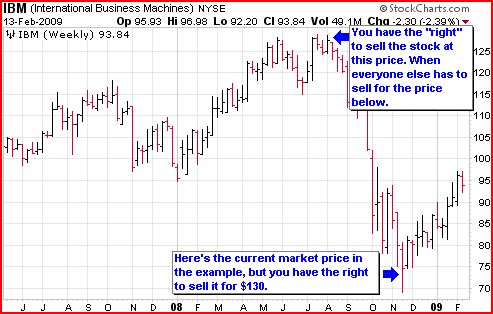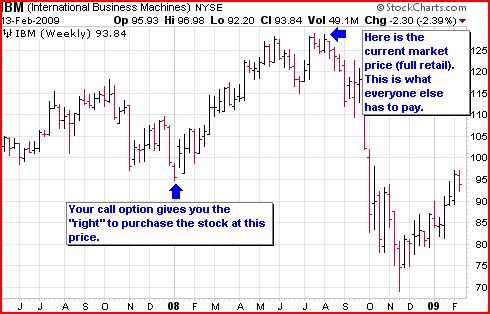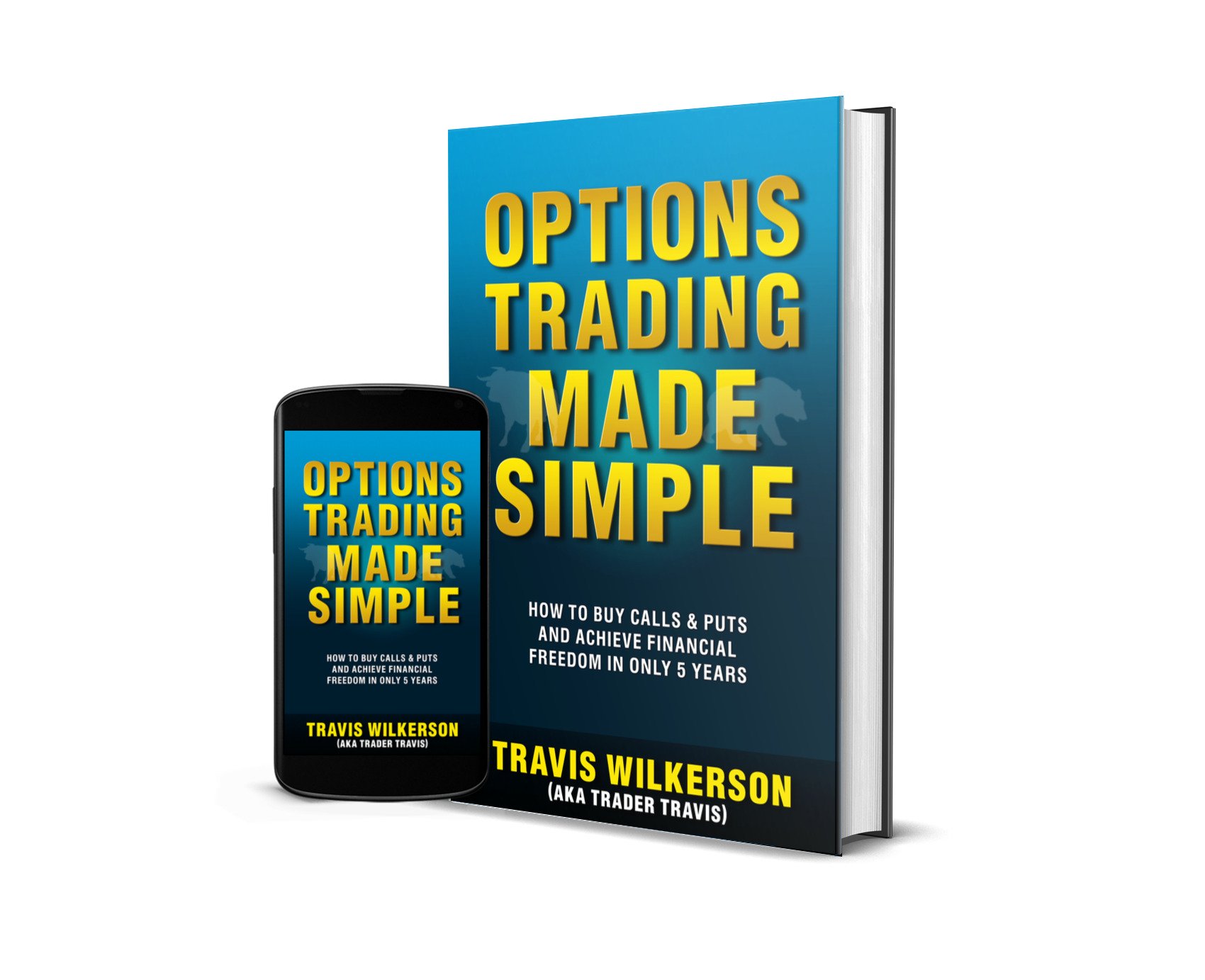"Understanding Puts and Calls So You Can Make Money Whether the Stock Market is Going Up or Down"
Puts and Calls are the only two types of stock option contracts and they are the key to understanding stock options trading.
In this lesson you'll learn how you can protect your investments and never fear another market crash again. I know how tough investing can be sometimes, but once you learn this skill you'll be able to make money in ANY market environment...
Understanding stock options is generally hard at first because there's so much information to take in. That's why I'm not teaching you any advanced strategies. My focus is on the basics.
So let's take this lesson a step further...
There are only 2 types of stock option contracts: Puts and Calls
Every, and I mean every, options trading strategy involves only a Call, only a Put, or a variation or combination of these two.
Puts and Calls are often called wasting assets. They are called this because they have expiration dates.
Stock option contracts are like most contracts, they are only valid for a set period of time.
So if it's January and you buy a May Call option, that option is only good for five months. The contract will expire or cease to exist in May, and when it expires so do all the rights the contract granted you.
Technically speaking, Puts and Calls expire the 3rd Saturday of the month of expiration. For example if I bought a December option, it will cease to exist (expire worthless) after the 3rd Saturday of December.
**However, stock option contracts cannot be traded on Saturday so for trading and practical purpose we say that stock option contracts expire on the 3rd Friday of the month of expiration.
Puts and Calls in Action: Profiting When a Stock Goes "Down" in Value
Buying "Put options" gives the buyer the right, but not the obligation, to "sell" shares of a stock at a specified price on or before a given date.
A Put option "increases in value" when the underlying stock it's attached to "declines in price", and "decreases in value" when the stock goes "up in price".
That one is worth reading again!
When you're first learning it's always hard to wrap your head around that concept. But once we break down how Puts and Calls work it should be easier to understand the above concept.
Remember Put options give you the right to "sell" a stock at a specified price. When you are buying Put options, you are expecting, or want, the price of the stock to decline.
For instance, if you bought an IBM December 130 "Put option", the option (contract) gives you the right to "sell" IBM stock for a price of $130 on or before the third Friday of December.
If IBM falls below $130 before the 3rd Friday in December you have the right to sell the stock for more than its market value.
So let's say that IBM falls in price to $76. Everyone else who owns the stock has to sell it for $76, but you own a contract that says you can sell it for $130!
Now can you see why Put option contracts go "up in value" as the underlying stock goes "down in price"?
The further the stock falls in price below your strike price ($130) the more valuable the option becomes.
**You hold a contract that says you get to sell something for more than its market value.
Someone who owns a great deal of that stock and is facing the pressure of selling it at $76 would love to own a contract that says they could sell it for $130.
And do you think they might be willing to buy that contract from you? Yup they sure would.

Now let's look at the opposite side of the equation. Let's say IBM was trading at $200 a share.
Who would want to buy a contract from you that gives them the right to sell it for $130 a share when they could easily sell it for $200 on the open market?
No one, which is why Put options "decrease in value" as the stock price "goes up".
Puts and Calls in Action: Profiting When a Stock Goes "Up" in Value
**Tip** The easiest way of understanding stock option contracts is to realize that Puts and Calls function opposite of each other.
Buying Call options gives the buyer the right, but not the obligation, to "buy" shares of a stock at a specified price on or before a given date.
Call options "increase in value" when the underlying stock it's attached to goes "up in price", and "decrease in value" when the stock goes "down in price".
Call options give you the right to "buy" a stock at a specified price.
You buy a Call option when you think the price of the underlying stock is going to go up.
In the example above let's say you bought an IBM December 95 "Call option" instead. This option gives you the right to "buy" IBM stock for $95 on or before the 3rd Friday of December.
Now imagine that IBM comes out with a new product and the stock shoots up in price to $127. You own a contract (Call option) that says you can purchase it for $95 a share.
Think shopping, you get to buy it at a ($32) discount or sales price when everyone else has to pay the full retail price.
So as the stock goes up in price, the 95 Call option goes up in value. A $140 stock price means you get a $45 discount in price etc. etc.

And vice versa, if the stock falls in price to $50 a share who wants to purchase a contract that gives them the right to purchase it at $95, when it's selling cheaper on the open market.
If you exercised the right and bought the stock at $95 you'd immediately be at a loss of $45 since the stock is trading for $50 on the open market.
That's the equivalent of someone trying to sell you a car for $2,000 when the market value of it is $1,500.
Lesson Review...
You use a Call option when you think the price of the underlying stock is going to go "up".
You use a Put option when you think the price of the underlying stock is going to go "down".
Most Puts and Calls are never exercised. Option Traders buy and resell stock option contracts before they ever hit the expiration date.
This is because minor fluctuations in the price of the stock can have a major impact on the price of an option. So if the value of an option increases sufficiently, it often makes sense to sell it for a quick profit.
If you have followed the lessons step by step and are confused, then I highly recommend you go back through Module 1 until you have a good grasp of the concepts.
Confusion on top of confusion just equals more confusion. Take the time to learn it right the first time; it will be well worth your time, because fully understanding stock options is key to consistent profits.
Before you leave, here's proof that options trading is changing lives.
The Passive Stock Options Trading Book Series
Discover how to achieve financial freedom in only 5 years...
Read what others have to say about the book. [Amazon affiliate link]
If You're Looking For A Reliable Lower Risk Way To Be
Profitable With Options, Try The "Buffett Strategy"...
I don't know what has brought you to my page. Maybe you are interested in options to help you reduce the risk of your other stock market holdings.
Maybe you are looking for a way to generate a little additional income for retirement. Or maybe you've just heard about options, you're not sure what they are, and you want a simple step-by-step guide to understanding them and getting started with them.
I have no idea if options are even right for you, but I do promise to show you what has worked for me and the exact steps I've taken to use them to earn additional income, protect my investments, and to experience freedom in my life.
If you want to learn more, I invite you to download a FREE video case study on how to trade options like Warren Buffett.
Inside you will discover...
- How investors pay me money to buy their stock.
- How "combining option selling with option buying" resulted in a 60% growth of my account.
- The "Family Freedom Fund" strategy I use to beat the market each year (I'm an experienced investor so your results may vary).
- And lastly, there is a high risk way to trade options and a low risk way. You'll discover a low risk "sleep well at night" method of investing.
Fill in your details below to download your FREE case study. Along with your case study, you'll also get my daily emails where I share my favorite option trading strategies, examples of the trades I'm currently in, and ways to protect your investments in any market.
Wealth Building Resources
Free Video Case Study (Newsletter)
Options Trading Made Simple Book (My Kindle book)
Options Wealth Academy (High End Training Program co-founded by Travis)
Free Options Course Learning Modules
|
Module 1: Option Basics |
Module 2: Option Value |
Module 3: Basic Strategies |
|
Module 4: Stock Charts |
Module 5: Technical Indicators |
Module 6: The 7-step process I use to trade stock options |
Learn Stock Options Trading Home Page
